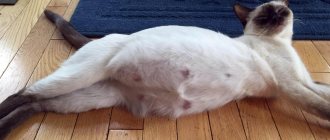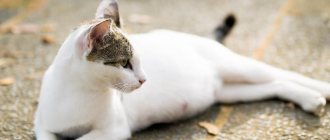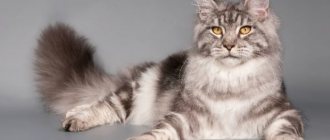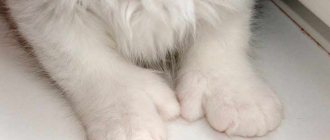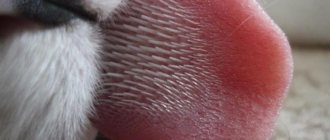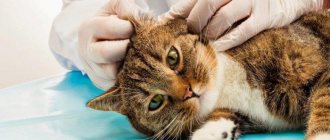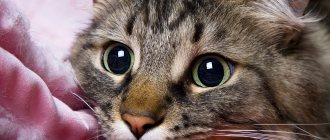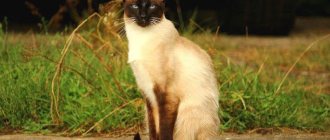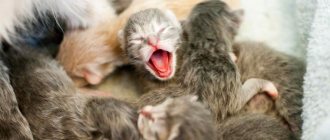Shedding in cats is a natural process of fur renewal. All cat breeds shed without exception. Cats that do not shed at all do not exist in nature. There are breeds that shed less due to short hair or almost complete absence of it: sphinxes, elves, Peterbalds.
Every owner should know the causes and timing of shedding, the features of caring for the cat and home during the shedding period, and ways to reduce hair loss . We'll talk about all this in our material.
What periods are considered normal for molting in terms of time of year and duration?
Seasonal coat change is a natural phenomenon that should not bother owners.
Cats shed their hair from time to time. The first hair change is called juvenile. A teenager changes his child's coat to an adult's one at six months of age, sometimes a little earlier or later.
Mature cats shed twice a year: in spring and autumn. This is how animals protect themselves from summer heat and winter frosts. This molting is called seasonal, or physiological.
The hair change process takes up to nine weeks. Shedding usually does not cause problems in pets of short-haired breeds.
Long-haired cats need help from their owners. If you do not comb out the hair that falls out, tangles form, within which ideal conditions are created for the reproduction of ectoparasites.
Caring for a cat during shedding period
When a cat begins to shed, it needs special care. The animal needs to be combed daily. To speed up the process, you can give your cat professional grooming or use a furminator. In addition, it is important to more thoroughly clean the house of lost hair.
Why is it important to remove dead hair?
Villi that have fallen out and have not yet settled on your interior cause severe irritation and itching on the cat’s skin. The animal tries to lick off the excess fur or comb it out somehow.
Why is it dangerous:
- Once in the stomach, hairballs cause gastrointestinal upset and can lead to intestinal obstruction.
- Scratched wounds are entry points for infection. This can lead to various skin diseases in your pet.
- If allergy sufferers live in the house, then fur flying around the house can trigger an allergy attack.
Tips for caring for a cat during shedding
- Buy everything you need to comb out excess hair: combs, brushes or brush gloves. The choice will depend on the length of the coat and the breed of “our little brothers”.
- During this difficult period for the animal, take care of a special product (Malt-Soft paste) that helps remove hairballs from the body of the shedding comrade.
- Consult with your veterinarian which vitamins are best given during the shedding period to facilitate and reduce the shedding of your animal.
Should I bathe my cat while shedding?
There is an opinion that during the period of changing the cat’s fur, it is necessary to wash it so that it does not develop an allergy. After all, the main allergen is not wool, but particles of saliva remaining after the procedure of washing oneself with the tongue. They dry out and spread along with the dust. And washing helps speed up the process of replacing an old fur coat with a new one.
Causes of severe shedding
Long-term intense hair loss is called pathological shedding.
It occurs for the following reasons:
- congenital anomalies;
- unbalanced diet;
- frequent bathing;
- stress;
- allergy;
- drug dermatitis;
- hormonal disorders;
- infectious diseases;
- oncology.
Congenital pathologies
With a genetic abnormality called hypotrichosis, the kitten's hair begins to fall out rapidly. By eighteen weeks the pet is completely hairless and remains that way for the rest of its life.
Also, a kitten may have a genetic predisposition to seborrhea or adenitis - hypersecretion of the sebaceous glands. An additional sign of the presence of one of these diseases is an unpleasant odor from your pet’s skin.
Be sure to read:
Why does a cat constantly scratch its chin: what kind of disease is it?
Unbalanced diet
Each cat has different nutritional needs. Some pets are not suitable for ready-made food, while others are not suitable for natural food. First, the fur stops shining, then it becomes disheveled and begins to fall out.
Sometimes the cause of deficiency is a changed physiological state.
A lactating female requires a diet richer in healthy components. Nutrients are primarily used to maintain vital functions and synthesize milk. The hair does not receive enough of it and therefore dies.
Not only a deficiency, but also an excess of nutrients has an adverse effect. Thoughtless use of vitamin supplements leads to poisoning. The body gets rid of toxic metabolites through diarrhea, vomiting, increased urination and shedding hair.
Frequent bathing
Cats can, but don't like to swim. They don't need bathing. Often overly caring housewives regularly wash their pussy. The shampoo degreases the hairs, they lose their protective layer, become brittle, and fall out.
Stress
A change of environment, a long journey, fear, jealousy, or a sudden change in diet can cause an inadequate reaction. The cat develops baldness in certain areas, sometimes half of the body.
Allergy
Hair loss is a side effect of medication.
Your pet may have an allergic reaction to:
- feed components, such as chicken or cereal proteins;
- odors, perfumes, tobacco smoke, pollen, fungal spores - atopic dermatitis;
- household chemicals, accessories, flea collars - contact dermatitis.
Additional symptoms of allergies are rashes, crusts and ulcers.
Drug dermatitis
Hair loss is a side effect of medication use. The course of treatment is interrupted and the drug is replaced.
Hormonal disorders
The main cause of hormonal disorders is diseases of the endocrine glands or regular use of contraceptives: Contrasex, Anti-meow, etc.
Contagious diseases
Hair loss in most cases is accompanied by a violation of the integrity of the skin.
It is provoked by the following diseases:
- lichen - a fungal infection of the skin;
- flea dermatitis;
- notoedrosis, demodicosis - lesions by intradermal mites;
- helminthiasis - infection by parasites.
Be sure to read:
Sores on a cat’s neck that itch and hair fall out: normal or pathological, reasons, what to do
Oncology
Cancer affects all life support systems, including hair follicles. The onset of tumor formation usually coincides with the aging of the cat.
Functions of the coat
Different hairs on cats have different functions. Topcoat hair covers the undercoat and skin. The sebaceous glands approach their base. Their secret prevents the wool from getting wet. In some breeds, the wool has a very high water-repellent effect, in others this ability is lower.
Downy hair forms a thermoregulating layer - it prevents the body from cooling down and overheating. The underpad also protects the surface of the skin from cracking, drying out, and damage. Wild cats, forced to wade through bushes for prey, have a denser undercoat. Through it, thorns and twigs cannot reach the delicate skin of the animal.
In addition, the pigment in the fur with a “wild” color allows the animal to merge with the surrounding landscape. Anyone who decides to get a pet that does not cause problems with shedding - hairless cats - is faced with the problem of caring for the pet's sensitive and delicate skin.
Hair also includes vibrissae - hard, long hairs located on the pads on the sides of the nose, above the eyes, on the lower jaw, and the back of the paws. Their length varies from 6 to 8-9 cm. Vibrissae are organs of mechanical sensitivity (tactile function).
A cat, having lost its fur coat along with whiskers and sensitive hairs on the body, loses confidence in movement. These hairs help determine the distance to objects, their temperature, atmospheric pressure and maintain the position of the body in space. It’s not for nothing that when a cat falls, it turns over so that it lands on its paws.
E. Filippova’s book “From a Cat’s Point of View” describes a case when a cat that fell into the tar had to be completely shaved. The poor thing was afraid to move actively until a new coat grew. Long sensitive hairs help plan a jump - they determine the speed and direction of air movement.
The hair density varies in different parts of the cat's body. For example, to protect the most delicate and vulnerable part of the cat’s body, nature has created a denser covering. There are more than 200 hairs per 1 mm2 of a cat's belly. There are slightly fewer of them on the back of the animal.
Each hair has its own muscle fibers. With any danger, temperature change, or excitement, the fibers contract and the coat rises. The matted fur of a cat during a fight or attack by an enemy increases the size of the cat's body, which should scare off the enemy. When the ambient temperature drops, the cat fluffs up its coat to increase the air “cushion”, which reduces heat loss.
Ways to reduce shedding
To reduce the intensity of hair loss, the root cause is eliminated. Cats suffering from seborrhea and adenitis are treated during exacerbations with external means - aerosols or ointments, which are prescribed by a veterinarian.
Hair loss from a lack of nutritional components is observed when feeding natural food, ready-made economy-class food. Some foods are not suitable for animals. Your veterinarian can advise you on which foods or supplements to use and which to avoid.
Sometimes hair loss stops if you stop bathing your pet frequently. When stressed, the fur grows back when the animal calms down. To do this, you need to play with your pet, pay attention to it, and pet it. They also use sedatives: Kot Bayun, Stop-stress, Feliway.
To treat infectious diseases, hormonal disorders, oncology and side effects of drugs, they seek veterinary help.
Long-haired pets are periodically combed.
Food during molting
Proper nutrition plays a big role in the process of hair loss. An unbalanced diet and the absence of elements important for the health and condition of the coat in the cat’s menu are one of the reasons for increased prolonged shedding.
What substances are necessary for a cat's fur?
In order for a cat’s fur to look beautiful and healthy, and for shedding to not turn into a painful year-round process, the animal’s diet must contain:
- Biotin (vitamin B7). The most important element for wool health. Its deficiency leads to the occurrence of inflammatory processes in the hair follicles. Because of this, the hairs become loose and fall out. Acute biotin deficiency leads to sudden baldness of the pet.
- Taurine. A lack of taurine leads to serious cat health problems, which affects the quality of the coat.
- Sulfur. Enhances the effect of biotin. Participates in the creation of keratin - the protein substance of wool.
- Vitamins B6, B2 (riboflavin) and B5 (pantothenic acid). A lack of vitamins of this group leads to deterioration in the quality of wool, its fragility and loss, and dermatitis.
- Iodine, calcium and phosphorus. A deficiency of these minerals leads to hair loss and dullness.
- Omega-3, Omega-6. Deficiency leads to dull fur and hair loss.
Natural products
A cat's natural diet must include foods containing biotin and vitamin B6:
- beef;
- pork;
- pork and beef liver;
- beef heart;
- chicken yolk;
- sardines, halibut, salmon;
- poultry meat;
- cheese;
- carrot;
- White cabbage;
- buckwheat.
Important!
Biotin is destroyed by frying. Products containing it are given raw or stewed.
Industrial feed
To ensure that the shedding process does not cause problems, and the pet’s coat looks well-groomed, healthy and beautiful, the cat’s diet should consist of high-quality food of at least “super-premium” class. These foods have a balanced composition, and the formulas contain all the necessary vitamins and minerals.
The pet industry produces two types of food that can be recommended by veterinarians during shedding:
- Food for healthy skin and coat.
- Food for removing hair from the stomach.
Both types of food solve problems that arise during shedding.
Popular brands of industrial feed:
- 1ST CHOICE “Healthy skin and coat”;
- Royal Canin Hair & Skin Care;
- Hill's "Wool Control";
- Eukanuba Adult Dry Cat Food Hairball Control Chicken;
- Bozita Feline Funktion Sensitive Hair & Skin dry food;
- Ontario for wool breeding;
- Monge Cat Hairball;
- Advance for hair removal.
How to relieve a cat's condition
Hypotrichosis is incurable. The animal will constantly freeze. Therefore, it is necessary to maintain an optimal air temperature in the apartment - 22-24 °C. If the owners decide to walk the cat in cool weather, they will have to dress it.
Long-haired pets are periodically combed.
In long-haired pets, in addition to excessive shedding, intestinal blockage may occur with trichobezoars - stones formed from a mixture of hairs swallowed while licking and the contents of the alimentary tract.
If the cat owner does not use special super-premium food, you will have to periodically give Malt paste, which prevents hair from clumping.
To speed up molting, special feed additives are used:
- Laveta Super from Beafar;
- Sherstevit;
- Gimpet.
Products based on brewer's or feed yeast reduce the duration of shedding. Caring for a shedding pet involves frequently combing out lost hair.
In advanced situations, the crumpled wool is removed using tangle cutters. If the cause of hair loss is a contagious disease, you must follow the instructions of your veterinarian.
Be sure to read:
Why does a cat bite and gnaw its tail strongly, sometimes until it bleeds? Should I be worried?
Hair loss is a serious symptom
Seasonal shedding in cats lasts from two to three weeks to one and a half months; the age-related change of coat in kittens can last for six months. In theory, anything outside these parameters should be considered an abnormality. But there is a nuance: as we said, after moving into houses, our smaller brothers can shed all year round, while remaining completely healthy.
Domestic cats can shed all year round
Yet hair loss in animals is often a symptom of a disease or other health disorder, and domestic cats are no exception. Thus, a paradoxical situation arises: the same external manifestations can be either a kind of “payment for shelter” or an alarm bell. In one case, nothing needs to be done, moreover, an attempt to treat the animal can cause harm to it, and in the other, the pet, on the contrary, needs qualified help. The problem is so difficult that even an experienced veterinarian is not always able to solve it. But a responsible animal owner simply must do this.
Let's start with something simple. It is not difficult to understand that a cat is shedding (losing fur). You can often hear advice to try, without making much effort, to pull out a tuft of hair from your pet’s fur coat, but believe me, this is actually not necessary. Just caress a purring animal, and you will see that a lot of fallen hairs will remain on your hands (try to pet a street cat, especially in winter, and you will see that its fur “fits” very firmly).
So the cat is shedding. Most likely, everything is fine with her if:
- the skin visible between the hairs retains a natural and uniform color;
- the fur does not fall out in clumps, leaving bare areas of skin (bald spots can appear behind the ears, above the eyes, on the stomach, thighs, and the inner surface of the paws);
- the pet’s behavior has not changed, the cat looks healthy, eats well, digestion is not upset;
- urine and feces have normal color and odor;
- the animal's nose is moist, its eyes are shiny;
- there is no frankly unpleasant odor from the mouth;
- body temperature, if you can measure it, is normal (for cats this is the range between 38.0 and 39.0 ° C).
In a word, you need to understand a simple thing. Hair loss is almost never the only symptom of a particular disease: as a rule, there are other signs. Finding them or making sure that they are absent is the main task of the owner.
Let's look at some of the most common causes of pathological hair loss in cats.
Hormonal disbalance
When experts strongly recommend sterilizing domestic animals of both sexes (with the exception of those specifically used for breeding), they know what they are talking about.
It has been observed that sterilized cats live an average of 15–20 years. For comparison, the average lifespan of a domestic cat is 10–12 years; outdoor cats rarely live past 5 years of age. And if the difference between a pet and an animal forced to fight for survival can be explained by the quality of life (in civilized countries people also live longer than in backward ones), then the obvious advantage of sterilized animals over their no less “caressed” brothers is explained by only one thing - the absence hormonal shocks.
In favor of sterilization, it should also be said that cats, like the vast majority of animals, do not have such a thing as orgasm. Mating and childbearing, contrary to the opinion of some “humanists,” are not beneficial to the cat’s health; this is just a natural need to preserve the species, which in the case of pets is perfectly solved through targeted breeding. If you do not agree with the position accepted as the basis throughout the civilized world, at least take the trouble to ensure your animal’s full realization of sexual instincts, but under no circumstances do you stuff it with hormonal drugs that suppress sexual desire, and do not endure heart-rending screams while clenching your teeth unfortunate beast. This is inhumane and very dangerous for the cat’s health.
Estrus causes a lot of inconvenience for a cat and its owner.
Severe hair loss is often caused by hormonal imbalance, and the latter, in turn, is inevitable when taking various “anti-sex medications.” The same reason, by the way, explains the increased shedding in cats after estrus, during pregnancy and after childbirth: hormones go crazy - just like in humans.
The author has heard complaints from cat owners who decided to sterilize their pets and were faced with the fact that after the operation, the fur literally came out of the animal in clumps. A few months after sterilization, the cats, however, fully recovered, and the problem of hair loss no longer bothered their owners. But the reason here is completely different - the stress suffered due to the operation and anesthesia.
Stress
We come to another problem that can cause hair loss. This is an emotional shock.
Cats, fortunately, have a fairly stable psyche. The author was lucky enough to keep a couple of chinchillas in the house; these animals usually did not shed, but at the slightest fright, tufts of loose hair instantly appeared on their coats. An offended cat is more likely to “sulk”, put the owner “ignored”, or begin to plan an act of retaliation (and, no doubt, will finish what he started).
Usually a cat knows how to stand up for itself
But there are factors to which even these proud and independent creatures react very painfully. These include, in particular:
- moving (the well-known formula that a dog is attached to its owner, and a cat is attached to the house, is only partly true, but there is certainly some truth in it);
- transportation, especially in tight carrying;
- painful medical procedures associated with anesthesia, fixation (tying up) and other violations of “personal integrity”;
- the appearance of another animal in the house, especially if it is perceived as a source of danger or a “competitor”;
- loneliness, especially if for the first time the animal is left alone in an empty room for a long period of time;
- a sharp change in attitude towards oneself on the part of the owner;
- the introduction of new rules and restrictions that did not exist before (for example, a cat got used to sleeping with its owner, and at some point they stopped allowing it to do so).
I will give two examples from my own practice.
The first days after the birth of our daughter, we were so tired that we literally fell off our feet, and when the Angora cat, who had lived in our house for ten years and knew the “rules” well, happily jumped onto our laps in anticipation of the allotted portion of affection or sniffed the crib with curiosity, trying to get acquainted with the new tenant, she was usually impatiently driven away. I admit honestly: I don’t remember whether the poor animal’s shedding intensified, but at some point we simply did not find the cat in the house. She quietly slipped out the door, unable to forgive the betrayal. The search did not yield any results.
The second example is directly related to molting. My daughter grew up and acquired an Abyssinian who literally idolized her owner. When the daughter left, there was no question of giving the animal to one of her friends or relatives: it was enough to look into the eyes of the animal, and the whole stupidity of the idea became clear. We just took turns going to feed and check on the cat. She accepted the food with cold dignity and even restrainedly allowed herself to be stroked. But when the red-haired beast dispassionately jumped from our laps, a dense layer of fur remained on our clothes. Moreover, just a few days after the owner returned, the severe molting inexplicably stopped by itself.
The cause of hair loss may be longing for the owner
In a word, if a cat begins to lose a large amount of hair, think about whether something has happened that has provoked strong feelings in the animal.
Allergy
Allergies in cats are usually accompanied not just by hair loss, but by the formation of bald patches (so-called alopecia). But the opposite rule does not work: allergies are not the most likely cause of baldness in individual areas of the skin, and their localization in this case will not clarify anything.
One of the causes of receding hairline is allergies.
The only correct course of action is to analyze whether there have been any changes in the diet, and if there have been, exclude the probable allergen, and then continue observation.
Poor nutrition and dysbiosis
A cat's diet must be balanced; food from our table cannot replace it. High-quality cat food contains everything necessary for the health of the animal. Adherents of natural food need to put in a lot more effort to make their pet's coat shiny and glossy.
High-quality cat food contains everything necessary for animal health
Sometimes the cause of hair loss is dysbiosis, which is not caused by nutritional problems, but, for example, by recent antibiotic treatment. In this case, shedding is usually accompanied by other characteristic symptoms, primarily intestinal dysfunction.
Once we acquired a breeding kitten, which by the time it moved to a new home was observed, as they say. The road was long, planned in advance, and I didn’t want to change plans. When we found traces of bloody diarrhea all over the apartment the next morning, an urgent visit to the vet seemed completely normal. The doctor, having learned that the animal had been purchased the day before, also seemed to reasonably decide to play it safe and prescribed several “killer” injections for the kitten. At the same time, a blood test was taken, but it did not reveal any of the diseases that the doctor feared. However, the job was done. Weakened by an intestinal disorder and experiencing stress from a change of environment, as well as separation from its mother and brothers, the animal received a heavy dose of antibiotics, from which it could not recover for a year. Throughout this time, the unfortunate child suffered from severe diarrhea and desperately shed.
Old age
As we age, various diseases appear and worsen, and the body begins to work like a poorly regulated machine. The same thing happens with cats. In an older animal, the fur coat loses its thickness and silkiness, becomes tangled and falls out, sometimes forming quite distinct bald spots. This is a natural and, unfortunately, irreversible process.
In old age, the animal’s fur no longer looks thick and silky.
Diseases and parasites
Increased hair loss can be a sign of a disease, either skin, caused by parasites or fungal infections, or internal.
The first category of diseases includes:
- ringworm (fungal infection, pathogens - dermatophytes);
- demodicosis (caused by subcutaneous mites);
- dermatitis (can be caused by bacteria, fungi and even flea bites);
- scabies (caused by the Notoedris cati mite);
- eczema (can be caused by various reasons).
All these diseases have a very clear clinical picture, the lesions are clearly visible, and if you consult a specialist in a timely manner, diagnosis and treatment do not cause problems.
Ringworm is an infectious skin disease of a fungal nature.
The situation is more complicated with systemic internal diseases, which at a certain stage begin to acquire external manifestations, affecting, in particular, the quality of wool. In fact, this symptom can be caused by literally anything: from endocrine system disorders, including diabetes, to neoplasms. In such cases, hair loss is a secondary symptom; therefore, there is no point in fighting it: you need to look for the cause of the disease and treat it.
Vitamins for cats
Cat owners have a choice: give imported complete food of premium class and higher or use natural food. In the first case, vitamins are not needed. They are included in the finished dry food in the required quantities and optimal ratio.
If the owner uses an unbalanced diet, the pet may develop problems with its coat. The problem is eliminated with the help of complex vitamin and mineral supplements.
Cat lovers prefer to use the following drugs:
- Felvit Multi;
- Kitty's +Taurine-Biotine;
- Gimpet Katzentabs;
- Laveta Super;
- Kitty's +Taurine-Biotine/Proteine/Cheese (vitamin mixture for cats);
- vitamins Doctor ZOO.
Tools and materials
The salon uses a furminator and special shampoos for fluffy cats to carry out the procedure.
To carry out this procedure, the pet salon uses:
- Furminator and stripping devices. They need to get rid of undercoat and dead particles of fur.
- Specialized shampoo and conditioner for fluffy cats.
- Hairdryer or professional compressor with high power.
- Film or cellophane bag.
- Slicker combs - 2 pcs. One with short stubble, the second with long.
- Massage silicone brush for washing.
Stages of implementation
If the express molting procedure is carried out at home, then first of all, you need to pick up the cat and calm it down by gently stroking it. Place in the bathtub, initially filling it with warm water up to your ankles. Then, without haste, generously moisten the animal’s fur and apply a special shampoo. Lather well and distribute it over the entire surface of the body. Next, you need to wrap the cat in a soft cloth, wrap it with film or a bag on top and throw a towel over it again. Take the animal to a warm place and keep it like this for half an hour.
After waiting the specified time, everything is removed from the cat and washed off with water. Under the jet, the fur is combed out in parallel with a slicker or massage brush. Then the fur is washed several times with shampoo. During bathing, it is recommended to comb the fur with a furminator. After this, apply conditioner for cat fur and rinse it off again. After taking all the water procedures, you need to blot the cat with a dry towel and dry it thoroughly with a professional hairdryer using a comb with different teeth. A prerequisite is that the hair must be combed against its growth. When the animal is completely dry, it is necessary to use stripping. At the end of the express molting procedure, you need to give your pet a tasty treat and praise.
Selection stage
Each cat hair has its own lifespan.
When choosing a kitten, people often ask the question which cats do not shed. Only hairless cats do not lose hair because they have no hair. Cats with lush fur shed frequently. People who are not ready for this should not have British or Persian cats. Those who like fluffy cats and are not afraid of constant cleaning of furniture should choose an American Curl or Turkish Angora. Adults of these breeds grow rich collars by the age of one year. However, their undercoat is loose. Shedding does not occur as intensely in short-haired cats. They have a smooth, well-fitting coat. She has no undercoat. Their guard hairs fall out in small quantities. Among them it is worth highlighting the Abyssinians and the Egyptian Mau.
Next, let's talk about which cats don't shed. These include such extravagant breeds as Devon Rex and Cornish. Sometimes their fur changes completely. In this case, the animals may develop bald spots. After some time, a new coat grows.
